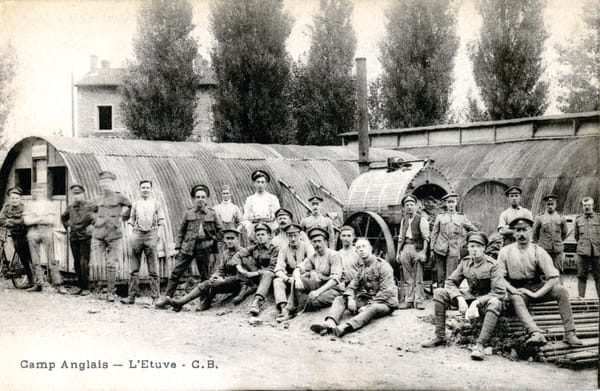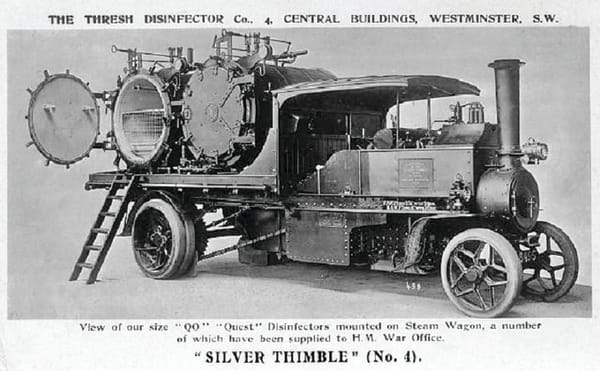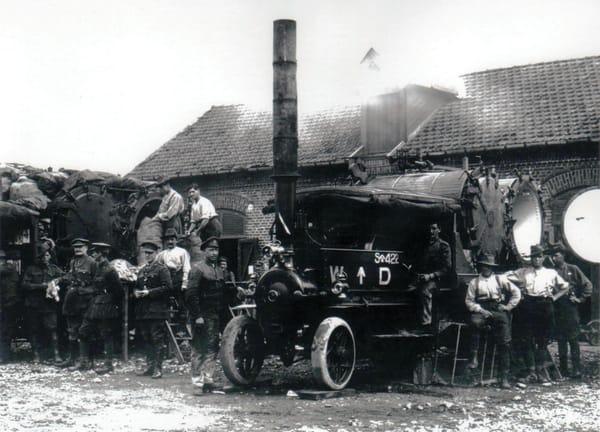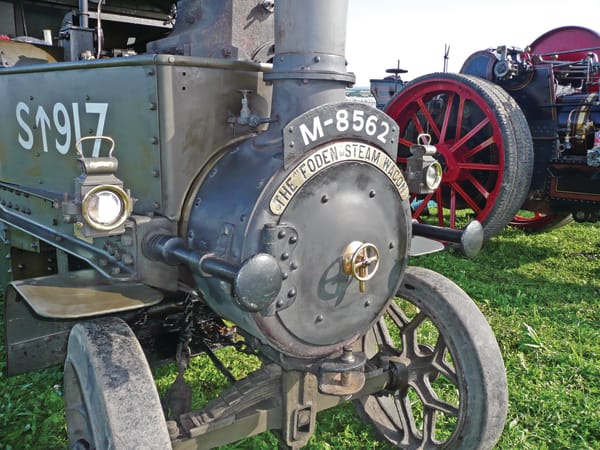In May 1918, five Australian Army Corps, under the total command of Lieutenant General John Monash as GOC, made history as the Australian Imperial Forces went in to action to achieve some of its greatest victories south of the Somme River, in the rolling fields of Picardy, France, forcing back the German Kaiser’s retreating armies.
I am sure this will be remembered with great pride in Australia in this 100th anniversary year, as John Monash, later General Sir John Monash (1865-1935), was a much respected and distinguished Army commander, loved by his men, and a holder of many War decorations. To remember these important times, I looked through my World War One photographic archives and discovered an historic vehicle picture. This tells a story not much known today.
It is well known that the French Emperor Napoleon Bonaparte said, “an Army marches on its stomach” meaning soldiers do not fight well without a good daily feed - this quote is also attributed to Fredrick the Great, King of Prussia. It is also well known that to keep their morale going, an Army also needs to have clean uniforms on a regular basis.
All over the Western Front and north Italian battle field areas, as well as other fronts in the Middle East at this time, as the conflict progressed and conditions steadily got worse, the British Government devised and introduced a method whereby when the soldiers left the Front Line trenches, with the horrendous conditions of mud, human waste, and other detritus of War, their uniforms and other clothing including bedding, were thoroughly cleaned to eradicate the verminous lice and other devilish mites which plagued all the Tommies and contributed to the poor conditions and helped spread diseases - all of which impacted on the effectiveness of the fighting forces. This was, of course, a huge operation with the many hundreds of thousands of military personnel on the Front which included the Australian Digger – War has always been a lousy business!
In 1904, the Thresh Company, who had offices in Westminster, at 66 Victoria Street, in central London, applied for a British Patent for an improved disinfector - a device which used hot steam from a boiler that was channelled into sealed chambers to fumigate infected clothing and bedding. The company, under the name of Summersides Ltd, had their Phoenix works at Keighley, west Yorkshire, where the Thresh Disinfectors were manufactured. The disinfectors were well known to the War Office as well as Crown Agents, and were known to have been sold in some numbers for use in the British Empire colonies. They were also supplied to Rural District Councils and hospitals.
Mainly during the 1900s, they were mounted on a specially designed type of horsedrawn 2-wheeled cart, with a single horse used for ease of movement, though they could be installed as a static unit (a 4-wheeled cart was also offered). It was insulated with wooden slats on the outside to keep in the heat for efficiency of use, and was of an oval design. The clothing and other items to be treated were put into a purpose-designed basket which closely fitted the interior of the disinfector. They had their own furnace at the bottom of the oval boiler.

One such example is in store at the well-known Beamish Industrial Museum in the north-east of the UK, and another resides in an Army museum at Quetta, India.
The (British) Army Service Corps (ASC) ran most of the transport on the Western Front and had many sections; one of great importance was the transport of clothing for the Royal Army Clothing Department. They had a huge amount of differing vehicles in both steam and petrol, which numbered over 38 makers, including British, French, Italian and American manufacturers. I would suggest that this would have been quite a serious headache when ordering spares? However, vehicles which could carry the greatest loads at this time where steam wagons.

So with most British makers being used, the famous firm of E Foden, Sons and Company Ltd, Elworth Works at Sandbach, Cheshire, in the north-west of the UK, were without doubt, the most prolific, with the Sentinel Steam Waggon Company of Shrewsbury coming in a close second.
Edwin Foden commenced trading in 1856, as a small agricultural machinery concern and proceeded to build stationary steam engines. By 1899/1901 they outshopped their prototype steam road wagon which achieved some success in the famous War Office Trials of 1901. Traction engines were also produced up until 1914 but were discontinued at this date. It is known that a fair number before that year were shipped to their well-known agents, Langwill Bros and Davies Pty Ltd, Melbourne, and were considered top quality by users, both in single cylinder and compound configuration.
The Foden 5 ton steam wagon was fitted with two road speeds (though 3-speed versions were also used) and, early in the War they were shod on steel wheels. Later, they were supplied with solid pressed rubber tyres for an easier ride and less road shocks to the vehicle. They were much favoured by the ASC for the fitting of these Thresh Disinfectors (a type of Autoclave as we would know them today). Two were fitted to the Foden’s rear tray and steam, at around 200lb per sq. inch, was supplied to them via a steam takeoff from the boiler. The heat from the steam not only eradicated the vermin, in particular lice, from the material but also dried it.

Some of the American troops later in the War, complained that this device was really too efficient, as it melted the buttons on their tunics! These Thresh units were also in use by the 26th Infantry Division (or Yankee Division as they were nicknamed) of the American Army on the Front, when they arrived in some numbers in France in 1917. It is known that a hundred of these Foden steam wagons where fitted with Thresh Delousing Chambers and all had two chambers mounted at the rear of the trays.
By 1918, at least 90 were at work on the Western Front, with five in Italy and three in England according to various reports. It is known that the first Australian Imperial Force soldiers moved into the Somme valley in July 1916, and soon the small town of Vignacourt was completely filled up with them, including as a home to the 61st Casualty Clearing Station where many Diggers were treated for their wounds - there were also large Australian camps very close by, at Pernois and Flesselles. These rest areas were on the south Somme and were a huge training area (not in the battle fields) used by all the Allies, where soldiers trained and rested, and were supplied with new uniforms, as well as personal items.
Although it is not known where the photo of the Diggers and the Foden wagon, fitted with the Thresh Disinfector, was taken, it is likely to be in this area of these small villages? Today, this district of Picardy still has very strong connections to the Anzacs. This part of France is north-east of the city of Amiens, and it is also interesting to note that the famous Australian World War One historian, Mr Charles Bean, had his Australian War Records section at Vignacourt, which was connected to the 1st ANZAC Corps Salvage Section. He collected many War items which today, form part of the Australian War Memorial’s massive collection at Canberra.

Foden 5 ton wagon, Build No. 7768, built October 1917
The 2017 Great Dorset Steam Fair held annually at the end of August, around a three hour drive west of London in the rolling hills of the West Country, is a fantastic event. Set out on farm land, the rally grounds cover over 600 acres (242ha) and has a large replica layout of World War One trenches and a Cavalry remount depot. It is an event with much going on, and one is hard pressed to see everything, even in a couple of good long days. Starting in 2014, the management decided to request owners of World War One vehicles to attend the rally to commemorate those used in World War One; owners have risen to the challenge over the last few years and will continue in 2018 to bring some very rare and interesting vehicles to this rally site.
One in particular, Foden wagon, No. 7768, is certainly the only one existing from the Great War era in original order that was displayed at last year’s event, though of course there are many Foden steam wagons in the UK in preservation today. Foden 7768 was shipped to France in 1917 and today carries a road-registered number plate, M 8562, which is quite possibly an age related plate. This engine was originally supplied new to the WD Roads Department to haul stone for effecting repairs to the roads behind the Front Lines. It was a huge and continuous effort by the lads operating these wagons as the roads were in constant need of repairing and upgrading, with some working very close to the Front Lines. Sometime in 1919, the British held a number of WD disposal sales in France (as they did in the UK) and this wagon was purchased by a Chicory producer in Cambrai in the heart of the battle fields area, who used it until 1948 when it was sold off to a local scrapyard. It is not known what it was used for by the grower but it is likely that it was used for soil sterilisation.
By 1976, it was purchased by an English steam collector and returned to its homeland after 59 years working and resting in a foreign land. It was restored at the well-known Kew Bridge Steam Water Pumping Station, now a museum in west London over a number of years.

Foden 7786 sports many original features from its World War One time. It has the original screw type rear tipping body to WD specifications i.e., high sides with the legend painted in white lettering, “Load not to exceed 5 tons” - which I am sure was exceeded many a time when a big battle field push was on! The tipping body was operated by a belt drive off the pulley on the flywheel on the left-hand side of the crankshaft, with the screw gear mounted on the rear of the cab. Perhaps more interestingly, it still has the twin spring-loaded buffers attached to the smokebox which butt up to the wagon’s chassis to take the shocks. These buffers were fitted to many such wagons for use in railway yards and docks operated by the Inland Waterways and Docks section of the Royal Engineers, to move trucks around – this wagon is the only one known today with these features. The cab also has a very nice period black-painted klaxon, fitted to the small wooden tool box at the rear of the cab, a fitting hard to find nowadays. A set of period paraffin side oil lamps complete the picture though many were supplied with a large oil lamp mounted on a bracket at the base of the chimney.
This Foden is painted as it would have been during the War, in War Department light khaki, making it a very distinctive vehicle. It is not known if the white lettering on the motion side aprons, S917, was the number it carried when operating on the Western Front, but it is known that there are many wagons painted with similar lettering and numbers which, of course, operated effectively as the WD registration numbers, for instance S254, S55 and S422 (the vertical arrow is standard). An average daily journey with a load of 4 tons was considered to be 25 miles (40kms) firing on coal. Also, on the left-hand side of the chassis at the front, there is lettering that indicates the allowed road speeds of the wagon - on steel shod wheels it is 5mph and on solid rubber tyres it is 8mph.
The Army Service Corps Mechanical Section ran extensive training courses for drivers and their mates in the operation and maintenance of their charges, and there were huge workshops in the rear areas of the battle fields to repair and service many kinds of road transport vehicles. It was taken very seriously if anyone was found not following the correct procedures and they were dealt with most severely; after all the vehicles were the King of England’s property (King George V)!
This article is respectfully dedicated to all the lads of the Australian Imperial Forces who served King and Country during World War One – Heroes All! *Tim Keenan





